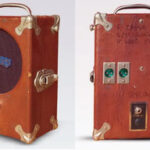The D9 Guitar Chord is a vibrant and essential chord in the vocabulary of any guitarist, adding color and sophistication to various musical styles. As a member of the dominant chord family, the D9 is rich in harmonic texture, making it a favorite in genres like jazz, blues, rock, and even pop. Understanding the D9 chord not only expands your chord knowledge but also deepens your grasp of guitar theory and chord construction.
If you’re venturing into the world of extended chords, the D9 is a fantastic place to start. Before we dive into the specifics of the D9, it’s helpful to understand the basics of chord construction. You might find it beneficial to explore resources that explain how chords are built using intervals, which will provide a solid foundation for understanding the D9 and other complex chords.
The D9 chord is built using specific musical intervals: the root (1), the major third (3), the perfect fifth (5), the minor seventh (b7), and the major ninth (9). These intervals combine to give the D9 its distinctive and alluring sound. To further understand how these intervals are arranged on the guitar fretboard, you might want to check out a guide on fretboard intervals.
Being a dominant chord, the D9 shares characteristics with the dominant 7th chord. Exploring the family of dominant chords can provide further context and understanding of the D9’s function and usage. Our tutorial on dominant (7) guitar chords can be a great resource to deepen your knowledge.
In this guide, we will explore the D9 chord in detail, providing you with chord diagrams and fretboard patterns to help you play it across the neck. We will also touch upon chord notation, which is crucial for understanding chord symbols and communicating with other musicians. For more information on this, our guide on how to denote chords is available.
Learning the D9 chord, along with other intermediate guitar chords, will significantly enrich your playing and open up new musical avenues. Let’s embark on this journey to master the D9 guitar chord!
Understanding the D9 Chord: Notes and Formula
The D9 chord is composed of five notes: D, F#, A, C, and E.
These notes are derived from the following intervals in relation to the root note D:
- 1 (Root): D
- 3 (Major Third): F#
- 5 (Perfect Fifth): A
- b7 (Minor Seventh): C
- 9 (Major Ninth): E
This combination of intervals gives the D9 chord its characteristic dominant quality with an added ninth, creating a richer, more complex sound than a standard dominant 7th chord.
The formula for a Dominant Ninth chord can be visualized in terms of intervals from the root:
| Interval | |
|---|---|
| 1 | Root |
| 3 | Major Third |
| 5 | Perfect Fifth |
| b7 | Minor Seventh |
| 9 | Major Ninth |
Exploring D9 Guitar Chord Positions
The D9 chord can be played in various positions across the guitar fretboard. Understanding these different voicings allows you to use the D9 chord in different musical contexts and seamlessly transition between chords. Below, we’ll explore several common and useful positions for playing the D9 chord.
Chord diagrams are presented from easier to more challenging positions. If you are new to reading chord diagrams, our tutorial on how to read chord diagrams will be helpful. For those who find barre chords challenging, our Bar Chords Tips tutorial offers valuable techniques and exercises.
Position 1: Open Voicing
This is an open position D9 chord, often considered one of the easiest ways to play the D9. It utilizes open strings, making it accessible for beginners while still delivering the full D9 sound.
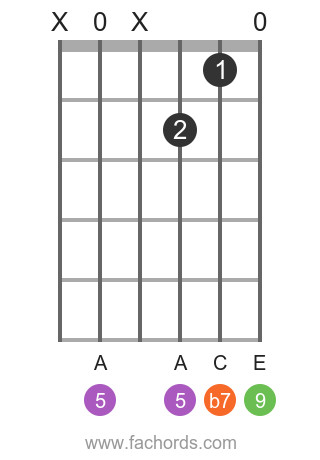 D9 guitar chord diagram position 1 open voicing. Learn how to play the D9 chord on guitar with this easy-to-read chord chart.
D9 guitar chord diagram position 1 open voicing. Learn how to play the D9 chord on guitar with this easy-to-read chord chart.
Position 2: Another Open Voicing
Here’s another open voicing for the D9 chord. This position offers a slightly different sound and feel compared to Position 1, providing another option for incorporating the D9 into your playing.
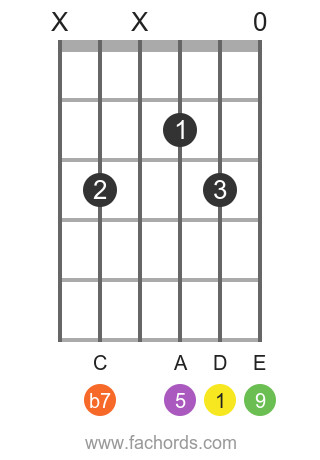 D9 chord diagram position 2 open form. Explore different ways to play the D9 guitar chord with open string voicings.
D9 chord diagram position 2 open form. Explore different ways to play the D9 guitar chord with open string voicings.
Position 3: Movable Shape
This D9 chord position is movable, meaning you can slide this shape up and down the neck to play a 9th chord with different root notes. This is a valuable shape to learn for understanding chord relationships across the fretboard.
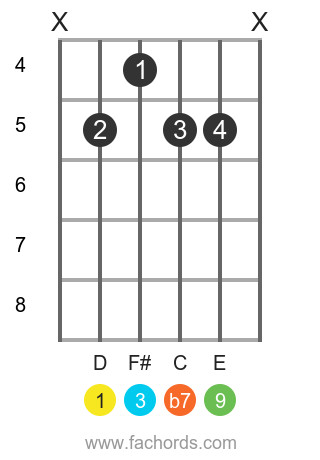 Movable D9 guitar chord shape position 3. Learn to play the D9 chord in a barre chord style that can be moved up and down the guitar neck.
Movable D9 guitar chord shape position 3. Learn to play the D9 chord in a barre chord style that can be moved up and down the guitar neck.
Position 4: Open String Variation
This is another open string variation of the D9 chord, providing yet another voicing option and potentially fitting more comfortably in certain musical passages.
 D9 open string guitar chord position 4 diagram. Discover various open string voicings for the D9 chord on guitar.
D9 open string guitar chord position 4 diagram. Discover various open string voicings for the D9 chord on guitar.
Position 5: Movable Barre Chord Shape
Another movable barre chord shape for the D9, this position offers a different tonal color and is useful for playing the D9 higher up the guitar neck.
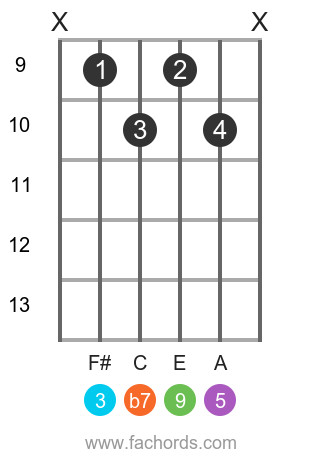 D9 movable barre chord shape position 5. A versatile D9 barre chord form for guitar, movable across the fretboard.
D9 movable barre chord shape position 5. A versatile D9 barre chord form for guitar, movable across the fretboard.
Position 6: Open Position D9
This open position provides another unique voicing for the D9 chord, expanding your options when playing in open positions.
 D9 chord diagram position 6 open form. Another open position voicing for the D9 guitar chord.
D9 chord diagram position 6 open form. Another open position voicing for the D9 guitar chord.
Position 7: Barre Chord D9
This barre chord position for D9 is movable and allows you to play the chord in different keys by shifting it along the fretboard.
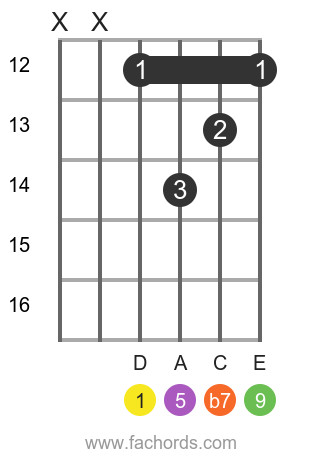 D9 barre chord movable shape position 7. Learn this movable D9 barre chord for playing in different keys on guitar.
D9 barre chord movable shape position 7. Learn this movable D9 barre chord for playing in different keys on guitar.
Position 8: Movable D9 Barre
Another movable barre chord shape for the D9, offering a different fingering and sonic texture compared to Position 7.
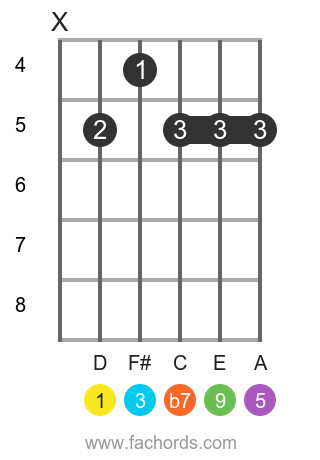 Movable D9 guitar barre chord shape position 8. Explore different barre chord voicings for the D9 chord on guitar.
Movable D9 guitar barre chord shape position 8. Explore different barre chord voicings for the D9 chord on guitar.
Position 9: Barre Shape for D9
This barre chord shape gives you yet another way to play the D9 chord, providing variety in your chord vocabulary.
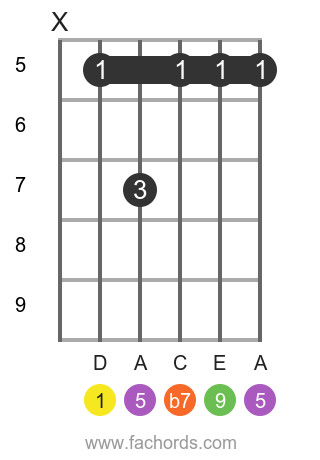 D9 guitar chord barre shape position 9. A different barre chord form for playing the D9 chord on guitar.
D9 guitar chord barre shape position 9. A different barre chord form for playing the D9 chord on guitar.
Position 10: High Position D9 Barre
This higher position barre chord allows you to play the D9 chord further up the neck, useful for solos or adding a brighter tone.
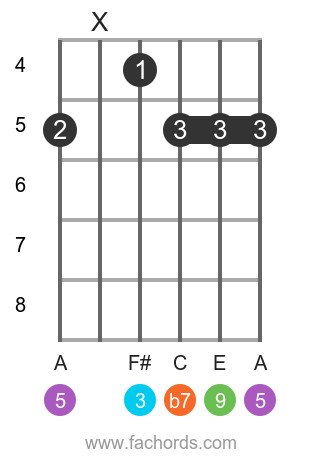 High position D9 guitar barre chord position 10. Play the D9 chord higher up the neck with this barre chord shape.
High position D9 guitar barre chord position 10. Play the D9 chord higher up the neck with this barre chord shape.
For even more chord shapes and variations, be sure to visit our comprehensive all guitar chords library. You can also download a handy Free Guitar Chords Chart Pdf for offline reference.
Play D9 with Different Root Notes
Expand your chord vocabulary by exploring other 9th chords! Here are some common 9th chords with different root notes:
C 9 | D 9 | E 9 | F 9 | G 9 | A 9 | B 9 | C#9 | D#9 | F#9 | G#9 | A#9 | Ab9 | Bb9 | Db9 | Eb9 | Gb9
D9 Chord Tones Across the Fretboard
The fretboard map below illustrates the positions of the D9 chord tones across the guitar neck. This is a helpful tool for understanding the chord’s construction and for improvising or creating your own voicings.
[Fretboard map showing tones of the D9 chord across the guitar neck]
By mastering these various positions and understanding the theory behind the D9 chord, you’ll be well-equipped to incorporate this rich and versatile chord into your guitar playing. Experiment with these voicings, practice transitioning between them, and listen to how the D9 chord enhances your music.

